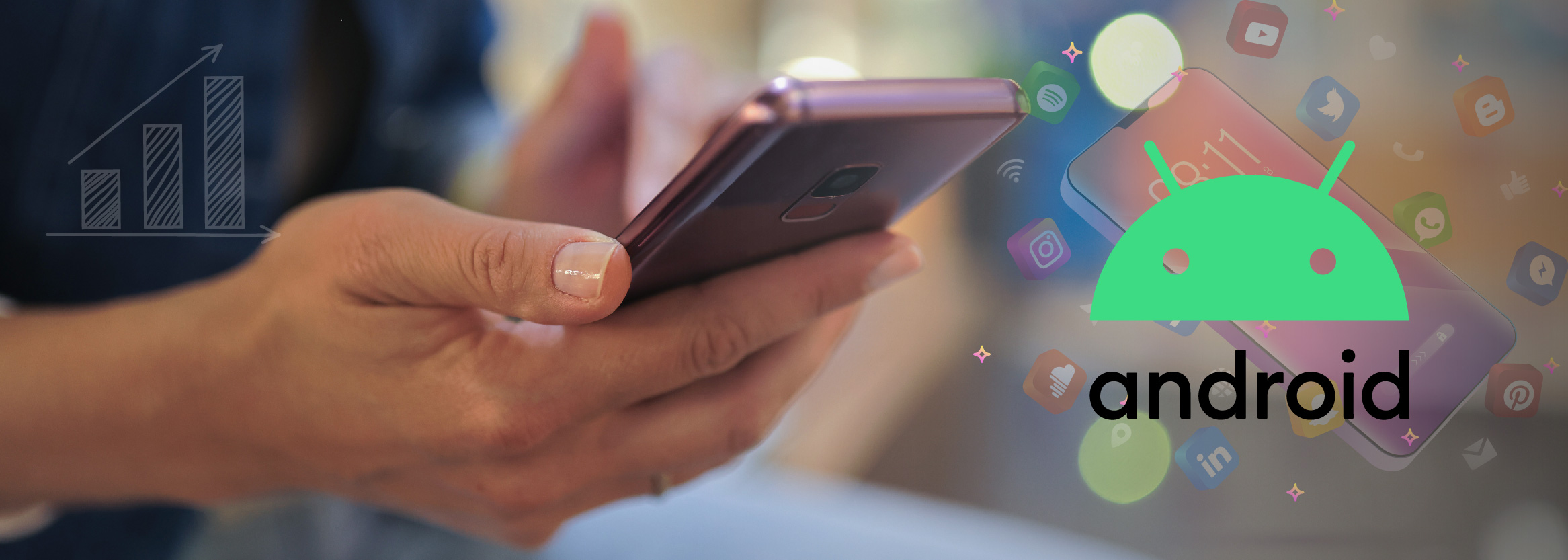Android Statistics and Facts: Android OS is a Linux-based mobile OS that runs on smartphones and tablets.
The Android platform features an operating system based on the Linux kernel, a web browser, and end-user applications available for download. Android’s initial demos had a generic QWERTY smartphone with a large VGA display. However, the operating systems were designed to be used on low-cost handsets with numeric keypads.
Android is based on open-source software. Android was released under Apache-v2 open-source license. Most Android devices are pre-installed with proprietary software like Google Maps, YouTube, and Google Chrome.
Android Inc., a Palo Alto start-up company, founded in 2003, was the first company to launch Android. Initial plans were to create an operating platform for digital cameras. However, Android Inc. abandoned these efforts to reach a wider market.
Google purchased Android Inc. and its key staff in 2005 for US$ 50 million. Google sold the first mobile platform to handset makers and mobile carriers, highlighting its key benefits, such as flexibility and upgradeability.
Market Share by Android Operating System
In 2022, the major market share of the Android operating system is held by Android OS version 11, with a total of 30% market. The second version is Android 10, which had a market share of 20.3%. Other top Android OS versions in 2022 are 9.0 (Pie – 11.5%), 8.0 (Oreo-8.2%), 7.0 (Nougat-5%), 6.0 (Marshmallow – 2.4%), and 5.0 (Lollipop – 2.1%).
Market Share of Android Phones by Model
In September 2022, the leading android phone model is the Samsung Galaxy A12, with a market share of 2.2%, followed by Samsung Galaxy A10s (1.1%), Samsung Galaxy A21s (1.0%), AFTMM (1.0%), Samsung Galaxy A51 (1.0%), Redmi 9A (0.9%).
Average Selling Price of Android Smartphones Worldwide 2017 to 2021
The global average selling price of android smartphones was US$ 235 in 2017, which increased to US$ 254 in 2018. The prices increased drastically in 2019 as the average selling price of android smartphones increased to US$ 269. In 2020, due to the COVID-19 pandemic, the demand for smartphones decreased, affecting the total selling prices, which dropped to US$ 250.
Leading Android Apps Worldwide by Downloads in 2022
In 2022, Dessert DIY is the most downloaded app, with total downloads of 21.88 million globally. The second most downloaded app is Bucket Crusher, with total downloads of 21.49 million. Dream wedding is the third most downloaded app globally in the same year as downloads reached 16.39 million.
Leading Android Apps worldwide by Revenue in 2022
Globally the android app that generated the most revenue is Coin Master, with total revenue of US$ 26.71 million, followed by Diablo Immortal, with a revenue of US$ 26.17. TikTok app ranks third with total revenue of US$ 23.5 million in 2022.
Android OS Version Market Share
As per android operating system versions, Android 11 holds a significant market share of 30%, followed by Android 10 with 20.30% in 2022. The Android version 9 has a market share of 11.5%.
Android Phone Manufacturer Market Share
In 2022, Samsung is the major market share holder in android phone manufacturers, with a total market share of 34.9%. Xiaomi is the second company in android phone manufacturing, with a total market share of 14.5%.
Market Share of Mobile Operating Systems Worldwide 2012-2022
Android and IOS are the two operating systems that hold about 99% of the global mobile operating systems market. In August 2022, the android phones market share in mobile operating systems was 71.47% followed by the IOS operating systems share of 27.88%.
Android Versions
Android operating systems keep on upgrading with changing technology. Each Android version comes with some new advanced features that improve user expertise and popularity of the Android compared to IOS. Following are the realized Android versions with their speciation.
Android Versions 1.0 to 1.1 – The Early Days
Android 1.0 version didn’t have a codename and made its public debut in 2008.
While things were basic back then, the software did include early Google apps such as Gmail, Maps, Calendar, and YouTube. This contrasted sharply with the more extensible standalone-app model used today.
Android Version 1.5 – Cupcake
Cupcake introduced many enhancements to the Android interface. It also included the first on-screen keyboard. This was important as phones began to abandon the once ubiquitous physical keyboard. With the Android 1.5 Cupcake launch in 2009, the tradition started naming Android versions.
Cupcake also introduced the framework for third-party app widgets. This quickly became one of Androids’ most distinguished elements.
Android Version 1.6 – Donut
Android 1.6 was introduced in Donut in the fall of 2009. Donut closed some of the gaps in Android’s central architecture. It allowed the OS to function on a wide range of screen sizes and resolutions, a feature that will be crucial over the next few years. It added support for CDMA networks like Verizon, which would be essential to Android’s explosive growth.
Android 2.0 to Android 2.1 – Eclair
Android 2.0, Eclair emerged six weeks after Donut. Eclair’s “point one” update, also known as Eclair, came out a few months later. The original Motorola Droid phone and the extensive Verizon-led marketing campaign made Eclair the first Android update to make it mainstream.
Android Version 2.2 – Froyo
Google’s Android 2.2 was launched four months later than Android 2.1. Froyo focused primarily on under-the-hood performance improvement.
Voice Actions allowed you to perform essential functions, such as making notes, getting directions by tapping an icon, and then speaking the command. Froyo provided some significant features on the front end, however. The dock was added at the bottom of the screen and the first incarnation of Voice Actions.
Android Version 2.3 – Gingerbread
Android’s original visual identity began to emerge with 2010’s Gingerbread release. Android’s robot mascot has always been bright green. Gingerbread made this a central part of the appearance of the operating system. Android made a slow but steady march towards a distinctive design.
Honeycomb Android 3.0 to 3
2011’s Honeycomb was a bizarre year for Android. Android 3.0 launched in the world as a tablet version. This was to accompany the Motorola Xoom’s launch. However, through the subsequent 3.1 & 3.2 updates, it remained a tablet-specific (and closed source) entity.
Honeycomb brought a radical reimagined Android user interface under the leadership of Matias Duarte. It was space-like, holographic, and replaced the platform’s traditional green with blue. The emphasis was on making the most of the tablet’s screen.
Android Version 4.0 – Ice Cream Sandwich
Ice Cream Sandwich – also released in 2011 – was the platform’s official entrance into the new age of modern design. The Honeycomb release refined the visual concepts and reunited tablets and phones with a unified UI Vision.
ICS dropped Honeycomb’s “holographic”, but maintained its use for blue as a system-wide highlight. It carried over core system elements such as on-screen buttons and a card-like appearance for app switching.
Android Versions from 4.1 to 4.3 – Jelly Bean
With three highly-recommended Android versions, the Jelly Bean 2012 and 2013 took ICS to a new level and made substantial improvements in fine-tuning and expanding on it. These releases gave Android a more welcoming experience by bringing lots of poise and polish.
Visuals aside, Jelly Bean brought about our first taste of Google Now — the spectacular predictive-intelligence utility that’s sad since devolved into a glorified news feed. It offered us interactive and expandable notifications, a voice search system, and a better system for displaying the search result.
Android Version 4.4 – KitKat
Late 2013’s KitKat release marked the end of Android’s dark era. The blues and blacks from Honeycomb and Gingerbread were gone. The OS’s appearance became more modern, with lighter backgrounds and neutral highlights. A transparent status bar and white icons gave it a more contemporary impression.
Android 4.4 introduced the first version of “OK, Google” support. In KitKat, however, the prompt was only activated if your screen was already. This means you had to be on your home screen or in the Google app.
Android Versions of 5.0 – Lollipop
Google reinvented Android with its Android5.0 Lollipop release in autumn 2014. Lollipop was the launch of the Materials Design standard. This new look is still available across all Android apps and other Google products.
Android’s card-based UI design was reintroduced throughout the OS. Notifications now appear on the lock screen and can be accessed from there. The Recent Apps list also takes on a card-based appearance.
Android Version 6.0 – Marshmallow
In the big scheme, 2015’s Marshmallow felt like a 0.1-level update rather than anything that merited a full number boost. It set the stage for Google to release one major Android version each year, with that version receiving its total number.
Android Versions: 7.0 – Nougat
Nougat brought some small but important improvements. Google’s Android Nougat 2016 releases featured a native split-screen mode and a new bundled app system for organizing notifications. There was also a Data Saver functionality.
Android Version 8.0 – Oreo
Android Oreo offered a host of additional features, such as a native image-in-picture option, a notification-snoozing feature, and notification channels that give you fine control over how apps notify you.
Android Version 9 – Pie
The fresh baked smell of Android Pie, A.k.a. Android 9, entered the Android ecosystem in August 2018. Pie’s most notable change was its combination gesture/button navigation system. Android’s traditional Back/Home and Overview keys were swapped in this system for a large multifunctional Home button with a small Back button.
Android Version 10
Google released Android 10 in September 2019. The first Android version to lose its letter. Instead, it was known as a number, not a name with a dessert theme. Most significantly, the software introduced a completely revamped interface for Android gestures. It no longer uses the tappable back button. Instead, the system relies on a swipe-driven approach to navigation.
Android Version 11
Android 11 – This was an impressive Android update. It was both under the hood as well as on the surface. The most significant changes are related to privacy. The updated version is built on Android 10’s expanded permissions system, allowing apps to grant permissions for the microphone, camera, location, and camera access only on a restricted, single-use basis.
Android Version 12
Google launched Android 12 as a final version on October 2021. Soon after, it began rolling the software out to Pixel devices.
Android Version 13
Android 13 was launched in August 2022. It’s one of Google’s most ambitious Android updates and the subtlest version change. It’s unusual duality. It all comes down to the type of device you use to use the software.
Top 10 Android Phone Manufactures
Samsung
Samsung Electronics was founded in South Korea. Samsung phones and smartphones are extremely popular because of their innovative technology and advanced features. The brand is known for its user-friendly technology and other features.
Samsung Galaxy S10 Plus, Galaxy S10e, and Galaxy S10e Smartphone Models are very popular.
The company holds 1st Place in Mobile Phone Manufacturing and Selling with around 28% Global Share in 2022.
Xiaomi
The history of Xiaomi with software updates is not good. In 2021, however, it changed its update policy. The company has committed to providing four years of security updates and three major Android updates. Update policies can vary depending upon the device series.
Redmi devices are guaranteed to receive one or two major Android updates. Redmi Note and Mi phones will get up to three significant updates. Starting with the Xiaomi 12 Pro, all flagship phones will get three major platform upgrades and four years of security improvements.
Oppo
Oppo, a Chinese company making consumer electronics and mobile communication devices, is in China. It is a prominent manufacturer of smartphones and other electronic devices. Oppo is a top manufacturer of smartphones and was China’s number one smartphone brand in 2016.
Popular Oppo android smartphones are OPPO F7, Oppo F3, Oppo F5, Oppo A71, Oppo F5 Youth, etc.
Vivo
Vivo company is one of the leading smartphone manufacturers. The company develops and produces smartphones, accessories, software, and online services.
Huawei
Huawei is a well know company in the smartphone market. It manufactures its brand of mobile phones as well as manufactures phones for other mobile companies. Huawei currently works with 80% of the world’s top 50 mobile and telecom companies.
Popular Huawei Smartphones are – Huawei P30 Pro, Mate 20 Pro, Huawei P30, P20 Pro, P20, Mate 20, Mate 20X, Mate 10 Pro, Mate 20 Lite, Huawei P Smart, etc.
Realme
Realme is a Chinese smartphone maker and consumer electronics producer based in Shenzhen. It is India’s fastest-growing smartphone company and consumer electronics firm.
Motorola
Motorola was an American multinational company. This company was the first to produce a mobile phone. The company was the top mobile phone manufacturer and was the biggest shareholder up to 1998. It has lost its market share and position because of a lack of R&D and poor marketing.
Later, in 2011, Motorola was separated into two independent public companies: Motorola Solutions and Motorola Mobility. Motorola Mobility was acquired by Lenovo company in 2014 after being taken over by Google. Popular Motorola Mobile Phone models include Moto G7 and Moto G6, as well as Moto G7 Power and Moto G7 Plus.
LG
LG is a South Korean multinational corporation. It is South Korea’s fourth largest electronics company. This brand is famous but not popular in mobile phone manufacturing.
Google
Google owns Android. Therefore, it makes sense that Android is one of the top smartphone brands for software updates. The company provides updates faster than most smartphone manufacturers and issues updates as soon as possible. Before it launched, Google promised three years’ worth of security updates and major updates for the Pixel 6 series.








